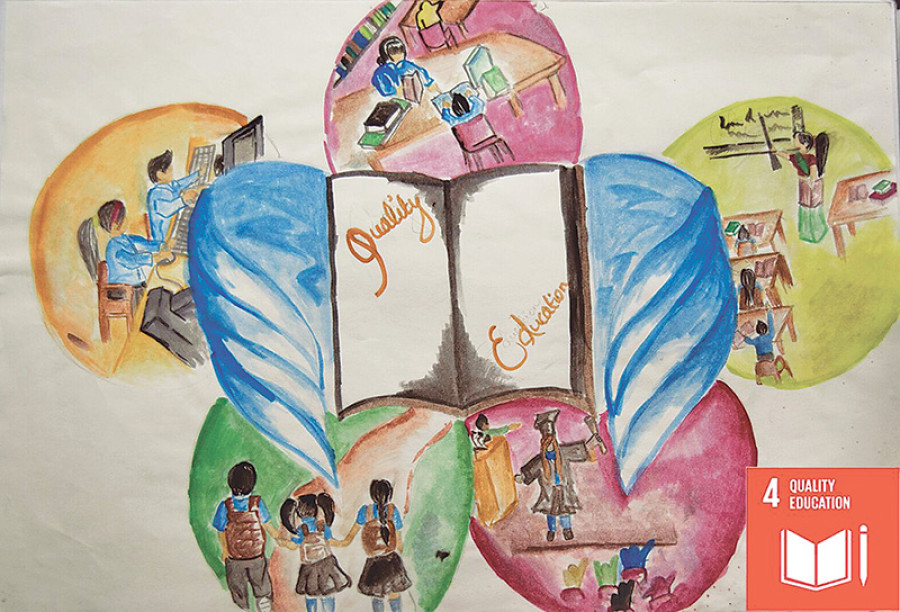Opinion
Quality education for all
A 16-year-old girl from a village in Lalitpur was selected by an international scholarship programme to study abroad with a full scholarship. She was encouraged to apply for the scholarship by a Teach for Nepal volunteer who taught at her school in the village. I can only imagine the doors of opportunity that it will open for her.
Prabal Gurung
A 16-year-old girl from a village in Lalitpur was selected by an international scholarship programme to study abroad with a full scholarship. She was encouraged to apply for the scholarship by a Teach for Nepal volunteer who taught at her school in the village. I can only imagine the doors of opportunity that it will open for her.
A 16-year-old boy from Dolakha had come to Kathmandu to become a porter, but upon receiving a scholarship, he went back to Dolakha to study and is now on his way to becoming a Junior Technical Assistant (JTA) in agriculture.
Taxing task
Both these students are recipients of scholarships from Shikshya Foundation Nepal, which I, with my siblings and friends, established five years ago. We believe that everyone has the right to high quality education and we invest in educational programmes with the goal of creating a critical mass of leaders who will be instrumental in turning the Nepali and global society into a thinking, questioning, equitable, secular and progressive place.
Such stories have strengthened my belief that education is key to escaping poverty because it empowers people to learn, challenge, innovate and develop skills.
As a global citizen (of Nepal and the US), I am more aware of how education and opportunities are closely linked. I grew up in Nepal, where my family instilled in me moral and ethical values, supported my dreams of becoming a fashion designer, and celebrated my differences. My mother, who remains my biggest source of inspiration and strength, always encouraged us to be aware of the time we have in this world and how we use it. She encouraged us to think for the community, the country, and the world, and not just for ourselves. I know I was among the lucky few who had education and access, which many still consider a privilege. However, I believe that education shouldn’t be a privilege. It is a basic human right regardless of gender, class, caste, sexual orientation, race or age.
Sustainable Development Goal (SDG) 4 aims to achieve equality in education and access for boys and girls by promoting child-friendly, student-centred, interactive and experiential learning taught by highly qualified teachers. One of the main obstacles we must overcome in order to achieve this goal is the issue of access.
While Nepal is ready and able to achieve the education goal, it does not come without its challenges. The physical geography of Nepal is an inherent obstacle that makes infrastructure projects such as building schools onerous. In addition, villages in Nepal are often remote, which makes hiring and retaining well-trained and dedicated teachers a taxing task.
Core issues
Along with focusing on building schools with better infrastructure and child-friendly environment, we must also find ways to hire compassionate, dedicated and well-trained teachers, who take their profession as a service to the nation rather than simply as a job. We must instil in our teachers the same level of pride and dedication to service as is present in the men and women in uniform.
We also face issues with the curriculum. In our own effort to find alternative routes to quality education, our foundation has partnered with Srijanalaya and developed a unique programme—Art Works! Sangai Khelaun—where various forms of art education lead to meaningful learning. Within this exercise, our aim is to find ways to make the curriculum more child-friendly and creative, as opposed to putting an emphasis on rote learning, because we strongly believe that holistic education happens both inside and outside of the classroom.
Technology must also be an integral part of education. The non-profit sector is partnering with the Nepali government to bring modern technology, such as wireless internet, tablets, and remote teachers/classrooms to rural Nepal. Open Learning Exchange (OLE) is a pioneer on this front. Introducing technology will aid in building access to education in Nepal for students and teachers alike. Technology can assist in teacher training and development, which, in turn, will help the students.
Another core issue is girls’ education. Ever since I can remember, I have heard of ‘Chhorilai pani school pathau’ campaign by the government of Nepal. The government and public and private education institutes have made great progress and the emphasis on education is palpable. However, girl’s education remains a burning issue.
Please join us
I consider myself a feminist and stand for equality and human rights. I stood in solidarity with women and marginalised minorities at the Women’s March in New York on January 21 when similar marches were held across the world. This made me realise how closely connected we are, and that we are only as strong as our weakest are. Together we must actively fight for equality and access for all, whether
it be in basic and fundamental human rights, health care or education, to name a few.
Now is the time to further such activism to target every community in Nepal and ensure that every girl and child from every community goes to school. Year 2018 should be the year of ‘Tamang Girls Go to School’—followed by ‘Dalit Girls Go to School’ in 2019. With the active participation of each community to sustain these programmes, the government of Nepal and various (I)NGOs can provide support to these communities.
Our foundation and I are ready to contribute to achieve these goal. Please join us.
Gurung is a New York-based fashion designer. This article is part of a weekly series on SDGs




 9.12°C Kathmandu
9.12°C Kathmandu










